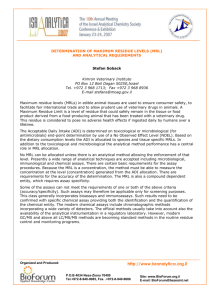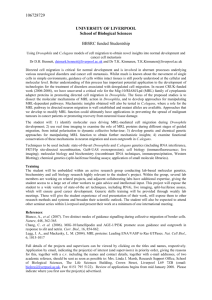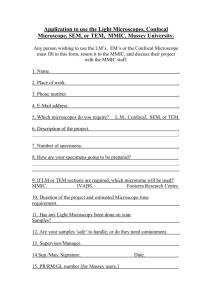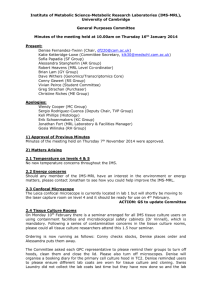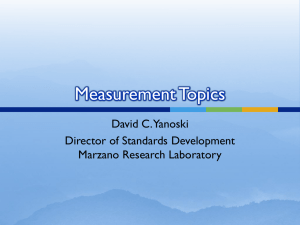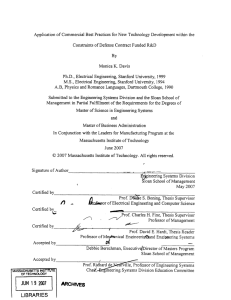Recent Defense Production Act Title III Investments in
advertisement
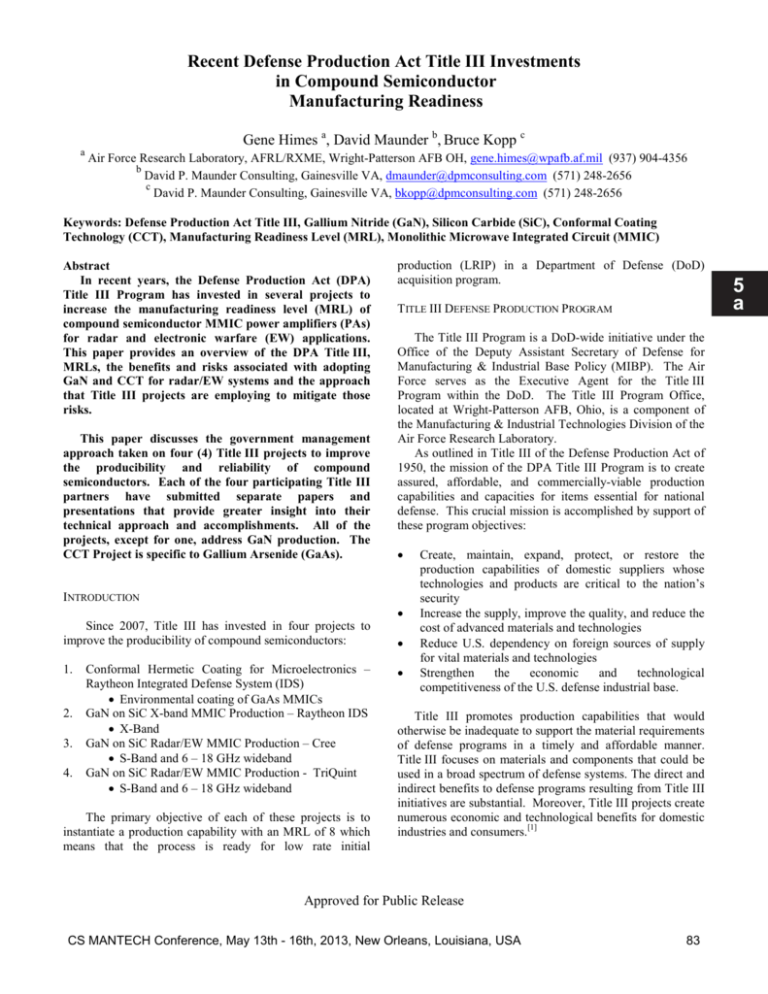
Recent Defense Production Act Title III Investments in Compound Semiconductor Manufacturing Readiness Gene Himes a, David Maunder b, Bruce Kopp c a Air Force Research Laboratory, AFRL/RXME, Wright-Patterson AFB OH, gene.himes@wpafb.af.mil (937) 904-4356 b David P. Maunder Consulting, Gainesville VA, dmaunder@dpmconsulting.com (571) 248-2656 c David P. Maunder Consulting, Gainesville VA, bkopp@dpmconsulting.com (571) 248-2656 Keywords: Defense Production Act Title III, Gallium Nitride (GaN), Silicon Carbide (SiC), Conformal Coating Technology (CCT), Manufacturing Readiness Level (MRL), Monolithic Microwave Integrated Circuit (MMIC) Abstract In recent years, the Defense Production Act (DPA) Title III Program has invested in several projects to increase the manufacturing readiness level (MRL) of compound semiconductor MMIC power amplifiers (PAs) for radar and electronic warfare (EW) applications. This paper provides an overview of the DPA Title III, MRLs, the benefits and risks associated with adopting GaN and CCT for radar/EW systems and the approach that Title III projects are employing to mitigate those risks. This paper discusses the government management approach taken on four (4) Title III projects to improve the producibility and reliability of compound semiconductors. Each of the four participating Title III partners have submitted separate papers and presentations that provide greater insight into their technical approach and accomplishments. All of the projects, except for one, address GaN production. The CCT Project is specific to Gallium Arsenide (GaAs). production (LRIP) in a Department of Defense (DoD) acquisition program. TITLE III DEFENSE PRODUCTION PROGRAM The Title III Program is a DoD-wide initiative under the Office of the Deputy Assistant Secretary of Defense for Manufacturing & Industrial Base Policy (MIBP). The Air Force serves as the Executive Agent for the Title III Program within the DoD. The Title III Program Office, located at Wright-Patterson AFB, Ohio, is a component of the Manufacturing & Industrial Technologies Division of the Air Force Research Laboratory. As outlined in Title III of the Defense Production Act of 1950, the mission of the DPA Title III Program is to create assured, affordable, and commercially-viable production capabilities and capacities for items essential for national defense. This crucial mission is accomplished by support of these program objectives: • INTRODUCTION • Since 2007, Title III has invested in four projects to improve the producibility of compound semiconductors: • 1. • 2. 3. 4. Conformal Hermetic Coating for Microelectronics – Raytheon Integrated Defense System (IDS) • Environmental coating of GaAs MMICs GaN on SiC X-band MMIC Production – Raytheon IDS • X-Band GaN on SiC Radar/EW MMIC Production – Cree • S-Band and 6 – 18 GHz wideband GaN on SiC Radar/EW MMIC Production - TriQuint • S-Band and 6 – 18 GHz wideband The primary objective of each of these projects is to instantiate a production capability with an MRL of 8 which means that the process is ready for low rate initial Create, maintain, expand, protect, or restore the production capabilities of domestic suppliers whose technologies and products are critical to the nation’s security Increase the supply, improve the quality, and reduce the cost of advanced materials and technologies Reduce U.S. dependency on foreign sources of supply for vital materials and technologies Strengthen the economic and technological competitiveness of the U.S. defense industrial base. Title III promotes production capabilities that would otherwise be inadequate to support the material requirements of defense programs in a timely and affordable manner. Title III focuses on materials and components that could be used in a broad spectrum of defense systems. The direct and indirect benefits to defense programs resulting from Title III initiatives are substantial. Moreover, Title III projects create numerous economic and technological benefits for domestic industries and consumers.[1] Approved for Public Release CS MANTECH Conference, May 13th - 16th, 2013, New Orleans, Louisiana, USA 83 5 a MANUFACTURING READINESS LEVELS Manufacturing-related impacts on cost and schedule of major acquisition programs have grown since the 1990s. In response, new policy has been established to address this problem in Department of Defense Instruction 5000.02, Operation of the Defense Acquisition System, dated 8 December 2008. It establishes target maturity criteria for measuring risks associated with manufacturing processes at Milestones A (Technology Development), B (Engineering and Manufacturing Development), C (Production and Deployment) and Full Rate Production. [2] Manufacturing readiness levels and assessments of manufacturing readiness have been designed to manage manufacturing risk in acquisition while increasing the ability of the technology development projects to transition new technology to weapon system applications. MRL definitions create a measurement scale and vocabulary for assessing and discussing manufacturing maturity and risk. A brief summary of the MRL levels is as follows: MRL 1: MRL 2: MRL 3: MRL 4: Basic manufacturing implications identified. Manufacturing concepts identified. Manufacturing proof of concept developed. Capability to produce the technology in a laboratory environment. MRL 5: Capability to produce prototype components in a production relevant environment. MRL 6: Capability to produce prototype system or subsystem in a production relevant environment. MRL 7: Capability to produce systems, subsystems, or components in a production representative environment. MRL 8: Pilot line capability demonstrated; ready to begin Low Rate Initial Production (LRIP). MRL 9: Low rate production demonstrated; capability in place to begin Full Rate Production. MRL 10: Full Rate Production demonstrated and lean production practices in place. Using the MRL definitions, an assessment of manufacturing readiness is a structured evaluation of a technology, component, manufacturing process, weapon system or subsystem. [2] A manufacturing readiness assessment evaluates the MRL of each of nine (9) threads and twenty-two (22) subthreads of a manufacturing process: 1. 2. 3. Technology & Industrial Base 1.1. Industrial Base 1.2. Manufacturing Technology Development Design 2.1. Producibility Program 2.2. Design Maturity Cost and Funding 3.1. Production Cost Knowledge 4. 5. 6. 7. 8. 9. 3.2. Cost Analysis 3.3. Manufacturing Investment Budget Materials 4.1. Maturity 4.2. Availability 4.3. Supply Chain Management 4.4. Special Handling Process Capability 5.1. Modeling and Simulation (Product and Process) 5.2. Manufacturing Process Maturity 5.3. Process Yields and Rates Quality Management 6.1. Quality Management 6.2. Product Quality 6.3. Supplier Quality Management Manufacturing Workforce 7.1. Manufacturing Workforce (Engineering and Production) Facilities 8.1. Tooling 8.2. Facilities Manufacturing Management 9.1. Manufacturing Planning and Scheduling 9.2. Materials Planning A comprehensive matrix is included in reference [2] that defines the attributes of each sub-thread for MRL levels 1 through 10. The overarching goal of each of the four Title III projects addressed in this paper is to support achieving MRL 8, which means that the manufacturing processes for MMIC components have been approved by the Recipient’s Technical/Management Review Board for release to production and are ready to support LRIP. Related objectives are to demonstrate relatively high yields and reliability and to reduce cost and throughput times. CONFORMAL COATINGS: BENEFITS/PERFORMANCE Integrating conformal coatings into the wafer fabrication process enables environmental protection of MMICs at lower cost than with the extant hermetic packaging technology. Hermetic packaging adds size, cost, and weight to MMIC assemblies and limits the interconnect technology between the internal components. Conformal coatings provide robust environmental (humidity) protection with minimal impact to radio frequency performance and field effect transistor reliability. Further, conformal coatings can enable greatly reduced process variability. CONFORMAL COATINGS: MANUFACTURING RISKS Inserting a new technology into an established GaAs MMIC foundry presents some degree of risk. Conformal coatings serve multiple functions in MMIC fabrication and Approved for Public Release 84 CS MANTECH Conference, May 13th - 16th, 2013, New Orleans, Louisiana, USA may affect both performance and reliability of a MMIC. Raytheon identified an extensive list of key performance parameters related to production (cost, yield, throughput, MRL), performance and reliability to retire risk during the project and ultimately transition CCT into their foundry. Phase III: Final Manufacturing Readiness Assessment. Significant quantities of wafers are produced to assess final process capability and yield. This final assessment is critical in demonstrating to DoD acquisition programs the maturity of the process. The goal of these Title III projects is to establish an MRL of 8 (ready for LRIP). GAN PAS: BENEFITS/IMPORTANCE CONCLUSIONS Phased array antennas are typically used for new DoD radar and electronic attack (EA) programs. Modern phased arrays typically utilize MMIC PAs at each antenna element in the array that drive key radar and EA attributes including radiated power, prime power and cooling. The PAs also indirectly drive system cost and weight. GaN PAs have demonstrated significant benefits through Defense Advanced Research Projects Agency (DARPA) programs in output power, DC power consumption (efficiency) and bandwidth vice conventional solid-state PA technologies. GAN PAS: MANUFACTURING RISKS Mature PA fabrication often is a significant system-level factor for development and production schedules. PA fabrication often requires greater than one year during development and production. PA cost is often significant in system production. GaN PA manufacturing processes, in general, are relatively immature compared to production GaAs PAs. Production immaturity increases the likelihood of: • • Rework or scrap during PA processing and associated significant system-level cost and schedule impact. Variability and defects in PA product with associated yield loss/cost and potential for latent defects/failures. MANUFACTURING RISK MITIGATION THROUGH TITLE III The Title III projects significantly reduce technology transition risk to DoD acquisition programs. Not only are the production processes refined as part of the Title III project, but significant quantities of wafers and MMICs are produced enabling rigorous assessment of yield, cycle time, RF performance and reliability. All Title III projects are structured in three phases: Phase I: Baseline Manufacturing Readiness Assessment. Significant quantities of wafers are manufactured to assess baseline process capability and yield. The baseline wafers provide data to identify root cause for variability and defects affecting yield, cost and schedule. Phase II: Improvement and Refinement of Processes. Employing six sigma methodologies, successive designed experiments are conducted to reduce product variability and defects. A related objective is to improve screening criteria to assure reliable lifetime operation. Advances in CCT and GaN technologies have demonstrated significant performance benefits for DoD radar and EA systems. Transition of these technologies into DoD acquisition programs introduces development risks due to relatively immature manufacturing processes. These risks are being mitigated through Title III projects. The projects are successfully targeting and achieving reduced PA process variability and defects to improve yield/cost and reliability. Equally important is reducing system manufacturing and integration costs of radar elements employing these advanced MMIC components. REFERENCES [1] DPA Title III Brochure, 2012, Manufacturing & Industrial Base Policy [2] Manufacturing Readiness Level Deskbook, Version 2.2.1, October 2012 ACRONYMS CCT: Conformal Coating Technology DARPA: Defense Advanced Research Projects Agency DoD: Department of Defense DPA: Defense Production Act EA: Electronic Attack EW: Electronic Warfare GaAs: Gallium Arsenide GaN: Gallium Nitride LRIP: Low Rate Initial Production MIBP: Manufacturing Industrial Base Policy MMIC: Monolithic Microwave Integrated Circuit MRL: Manufacturing Readiness Level PA: Power Amplifier SiC: Silicon Carbide Approved for Public Release CS MANTECH Conference, May 13th - 16th, 2013, New Orleans, Louisiana, USA 85 5 a 86 CS MANTECH Conference, May 13th - 16th, 2013, New Orleans, Louisiana, USA

